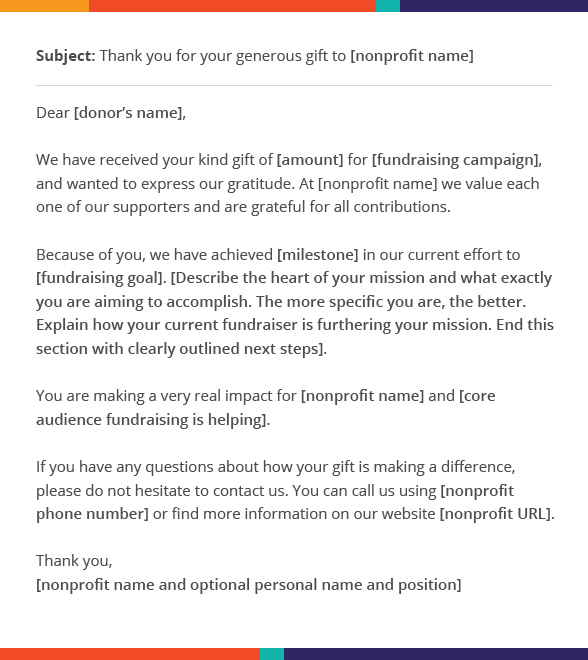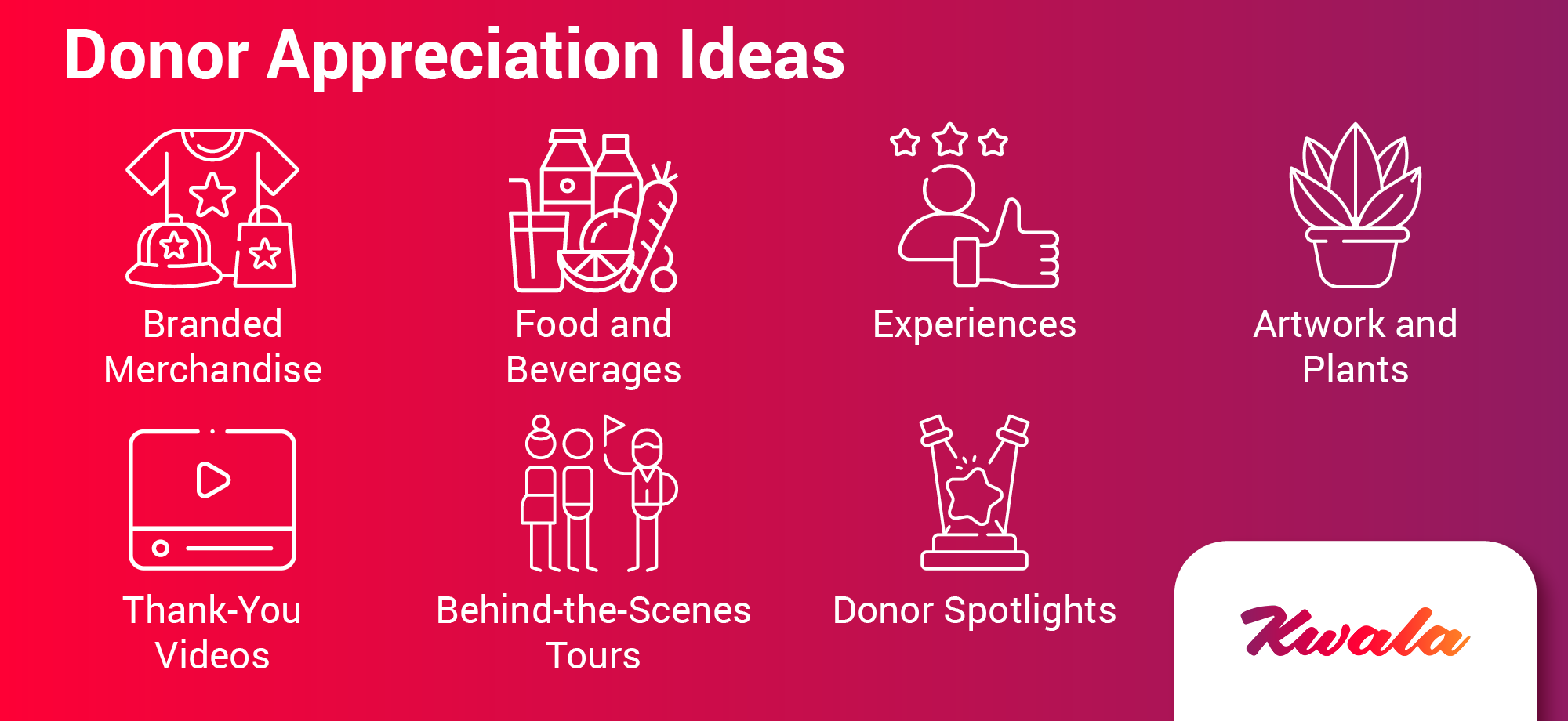
You have reached your fundraising goal! What’s next? Sending out a personalized thank you letter to your donors, of course! Without their contributions, your nonprofit would not be where it is today.
In fact, your thank you letter is hopefully the beginning of a mutually beneficial, productive donor relationship. Especially if a donor is new to your organization, a well-timed and thoughtful thank you letter acts as a warm invitation to your team.
In a world of instant messaging and speedy social media stories, a handwritten note adds an extra layer of pizzazz to your communication strategy. Unlike texts and social posts, a physical letter is tangible evidence that your nonprofit goes the extra mile when it comes to gratitude.
How do you write such a thank you letter? If you’re new to writing donor thank you letters, or need to jazz up your current thank you letter template, this article will give you some effective pointers.
Here’s an overview:
- Donor thank you letter best practices
- How to send a donor thank you letter
- Donor thank you letter template
- Other donor appreciation ideas
Donor thank you letter best practices
When it comes to writing your donor thank you letter, you want to make every line count. Thoughtful communication builds strong donor relationships. Generally, the best donor thank you letters are prompt, personable, and specific.
Prompt
Have you ever heard of the golden donation? This term refers to a donor’s second donation. When a donor contributes a second donation, they are much more likely to stay involved with your nonprofit long-term. That means that between the first and second donations, there is a perfect window to send out a donor thank you letter to show your appreciation.
Be prompt by sending out a thank you email within 48 hours of receiving a contribution. This ensures your donor is thanked in a timely manner. After this initial thank you, schedule when you will mail your thank you letters so they arrive ideally within one week of receiving the donation.
With this multi-channel strategy, donors will get confirmation their gifts were received and immediate appreciation through email. Then, several days later, they’ll be thanked by your nonprofit again when they receive a physical card in the mail, which may even remind them to make another donation later.
Personable
Personal details matter when writing donor thank you letters. Use your donor’s first and last name when addressing them. Additionally, when wrapping up your donor thank you letter, sign off with your name and position. For example, “All the best, John Jones, Executive Director of Paints For Kids”.
If your donor has been faithfully giving to your organization for several years, use your thank you letter to reiterate your appreciation. Use your donor management system to look up how long the donor has been involved in your organization and thank them specifically for their ongoing support.
Lastly, use your language to highlight their importance. Whenever you can, use “you” and “we” to reinforce a team-centric tone. For instance, phrases like “your gift helped us,” “your continued support,” or “because of you” reinforce your donor’s individual importance.
Our volunteer appreciation ideas guide also explains that you can add an extra layer of personalization by signing your letter from someone at your organization. Designating a specific sender will make it much more personable and meaningful.
Specific
Generic donor thank you letters are missed opportunities to connect. Let your donors know exactly how their gift made a difference. After all, most donors give to nonprofits that have the same values as they do. Of course, by nature, specificity looks different for every nonprofit. But as a rule of thumb, here are some topics to cover:
- Amount. This could look like “your $150 gift helped us care for three local families”. When you include the donor’s gift amount, it helps them understand their contribution’s ripple effect. It also indicates that you responsibly handle your donations.
- Gift type. Monetary gifts aren’t the only giving option. In-kind, pledge gifts, recurring gifts, event attendance, sponsorship, and many more gift types are available. Whichever gift your donor has chosen, let them know their generosity is appreciated.
- Impact. How exactly did your donor’s gift help? Perhaps their in-kind food gift fed or clothed four families or their monetary gift helped your organization build three new wells. When donors understand their impact, your mission becomes both immediate and real.
- Goal reached. When beginning your fundraising journey, you most likely laid out some goals to measure your success. If you’ve reached or surpassed those goals with your donors’ help, let them know! For instance, if you set to house 300 families, and have successfully housed 450, invite your donor to celebrate your nonprofit’s success.
Now that you have some tips to guide your donor thank you letter writing process, you might be wondering how you should send the letter. Let’s explore some options below.
How to send a donor thank you letter
When sending your donor thank you letters, you might be tempted to stick to one communication channel. However, using a variety of platforms, including email and text messages, ensures that your appreciation comes across in both a timely and thoughtful manner.
After all, marketing campaigns that use direct mail and one or more digital mediums experience a 118% boost in response rates compared to those using direct mail only. This means that implementing a variety of communication methods is the most effective way to reach your donors.
You can start by creating a thank-you template for all donors and tailoring it for each channel and recipient. For example, you might earmark places on your email template for inserting videos or make a note to keep your text messages to a certain number of characters.
Additionally, consider both your automatic and more personalized email templates. It’s a good idea to set up an automated message for donations that provides a donor receipt and confirms the gift was received. However, these emails won’t be as effective at showing gratitude as a personalized message that addresses donors by name and discusses other ways they can get involved to become part of your community.
Craft message templates for all of your donor thank you emails, and make plans to send physical thank you letters to these donors, as well. For direct mail, the process takes a little bit more planning, but we’ve included a template below to help you get started.

Donor thank you letter template
Sometimes it’s easier to write with a guide. Here is a donor thank you letter template for you to reference when crafting your donor communications.

Subject: Thank you for your generous gift to [nonprofit name]
Dear [donor’s name],
We have received your kind gift of [amount] for [fundraising campaign], and wanted to express our gratitude. At [nonprofit name] we value each one of our supporters and are grateful for all contributions.
Because of you, we have achieved [accomplishment] in our current effort to [fundraising goal]. [Describe the heart of your mission and what exactly you are aiming to accomplish. The more specific you are, the better. Explain how your current fundraiser is furthering your mission. End this section with clearly outlined next steps].
You are making a very real impact for [nonprofit name] and [core audience fundraising is helping].
If you have any questions about how your gift is making a difference, please do not hesitate to contact us. You can call us using [nonprofit phone number] or find more information on our website [nonprofit URL].
Thank you,
[nonprofit name and optional personal name and position]Key takeaways
Remember to be prompt, personable, and specific throughout your letter. Being specific about your donor’s impact on your fundraising event or project helps them put their gift into perspective. Plus, your contact information provides your donor with the next steps for future engagement.
Other donor appreciation ideas
Thank you letters aren’t the only way to show your donor appreciation. Handwritten letters pair well with lots of other donor gifts. Consider both your audience and your budget to determine which gift would make them feel the most appreciated.

Branded merchandise
Quality branded tote bags, journals, beanies, blankets, or hoodies are great donor gifts. Especially as the year gets colder, gifts that will keep your donor warm let them know that you are grateful for them. When each of these items has your logo, it also acts as advertising for your nonprofit.
Think about quality and practicality when choosing your merchandise. Useful items like pens and notepads can help your donors stay organized in their busy schedules. It’s better to choose fewer quality-made items than lots of cheaper trinkets.
Food or coffee
This is a practical choice that most donors will love. Consider fruit baskets, dessert trays, or a charcuterie board to gift your donor with. If, like most people, your donor is a sucker for caffeine, track down some quality coffee grounds. Or, if they enjoy the occasional cup of tea, find some flavorful tea varieties.
Experience
This donor gift is for the memory-makers. Many donors prefer an experience over receiving a material item. These experiences do not have to be flashy. Rather, they can reflect your donor’s interests, nonprofit goals, or location. For example, if your nonprofit is dedicated to serving a more artistic community, tickets to a local music festival or painting class are a great option.
Artwork or plants
Many donors also enjoy supporting local artists. Jewelry, paintings, ceramics, and prints are all options. Search for a landscape of their city or a fun vase to place flowers in. Full-grown plants or garden seeds make for fun donor gifts as well. Some vegetable seed packages come with a plan for recipients to eventually make their own salad or pizza toppings.
Thank you video
Show your mission in action with a thank you video! Testimonies from your beneficiaries, staff, volunteers, and management illustrate your gratitude for your donor’s contributions. These videos do not need to be long, they just need to make your donor feel appreciated and a part of a team.
Behind-the-scenes tours
Invite locally based donors to come down to your office or a program site to see the work your nonprofit does every day. For donors who live far away, or if it’s not practical to bring out donors, record a behind-the-scenes tour you can share with donors. This helps them feel like they’re a part of your organization and demonstrates exactly what their gifts help fund.
Donor spotlight
Expand your multi-channel appreciation strategy to include social media, your website, and your email newsletter with donor spotlights. Pick a few notable donors and ask if they would like to be celebrated through a donor spotlight, which would include their photo, a summary of their contributions, and a statement about why they support your nonprofit. Along with celebrating your donors, these spotlights can encourage others to make big donations in the hopes of getting a spotlight themselves.
Conclusion and Additional Resources
A well-written donor thank you letter will establish a strong foundation for your donor relationships. Include the impact your donor’s contribution made to your organization. Additionally, consider thanking your donor with a thoughtful gift to remind them of your genuine appreciation.
Here are some other resources to improve your donor communications:
- 15 Donor Gifts to Show Your Appreciation. Use these 15 donor gift ideas to showcase your gratitude.
- The Busy Nonprofit’s Guide to Donor Communications. Are you leveraging your donor network properly? Here is the full guide on how to upgrade your supporter communications.
- Fundraising Flyers: Examples and Tips to Make Yours Stand Out. Catch your donor’s eye with a well-designed fundraising flyer! Refer to this article for aesthetic tips and tricks.



